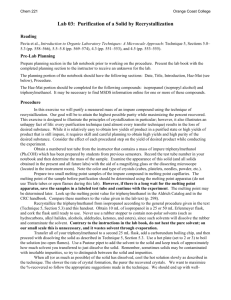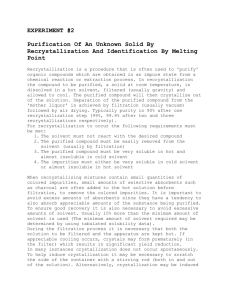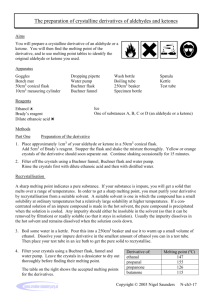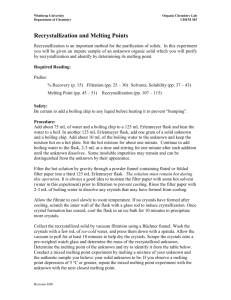Recrystallization of Impure Acetanilide and
advertisement
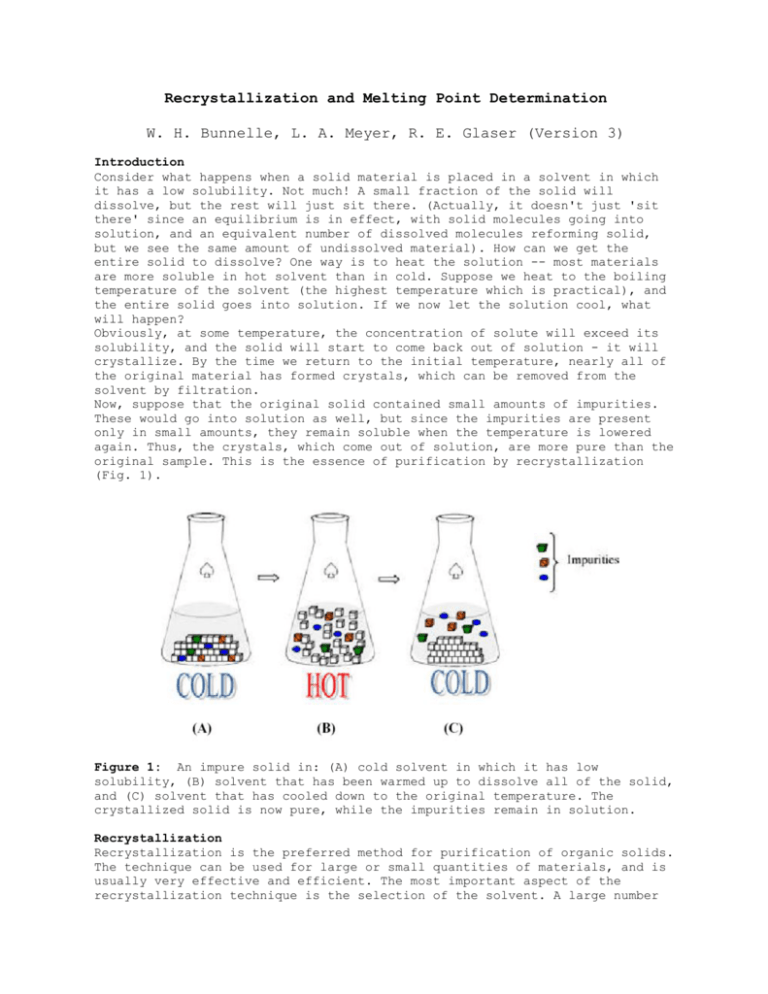
Recrystallization and Melting Point Determination W. H. Bunnelle, L. A. Meyer, R. E. Glaser (Version 3) Introduction Consider what happens when a solid material is placed in a solvent in which it has a low solubility. Not much! A small fraction of the solid will dissolve, but the rest will just sit there. (Actually, it doesn't just 'sit there' since an equilibrium is in effect, with solid molecules going into solution, and an equivalent number of dissolved molecules reforming solid, but we see the same amount of undissolved material). How can we get the entire solid to dissolve? One way is to heat the solution -- most materials are more soluble in hot solvent than in cold. Suppose we heat to the boiling temperature of the solvent (the highest temperature which is practical), and the entire solid goes into solution. If we now let the solution cool, what will happen? Obviously, at some temperature, the concentration of solute will exceed its solubility, and the solid will start to come back out of solution - it will crystallize. By the time we return to the initial temperature, nearly all of the original material has formed crystals, which can be removed from the solvent by filtration. Now, suppose that the original solid contained small amounts of impurities. These would go into solution as well, but since the impurities are present only in small amounts, they remain soluble when the temperature is lowered again. Thus, the crystals, which come out of solution, are more pure than the original sample. This is the essence of purification by recrystallization (Fig. 1). Figure 1: An impure solid in: (A) cold solvent in which it has low solubility, (B) solvent that has been warmed up to dissolve all of the solid, and (C) solvent that has cooled down to the original temperature. The crystallized solid is now pure, while the impurities remain in solution. Recrystallization Recrystallization is the preferred method for purification of organic solids. The technique can be used for large or small quantities of materials, and is usually very effective and efficient. The most important aspect of the recrystallization technique is the selection of the solvent. A large number of solvents are commonly used for recrystallization of organic compounds. Among these are water, ethanol, ethyl ether, and hexane to name just a few. A solvent, which works beautifully for one recrystallization, may be totally unsuitable for purification of a different compound - the choice for recrystallization solvent is made on a case-by-case basis. This is because of the variation of solubility of different organic compounds in these solvents. We can identify a set of characteristics which are desirable for a recrystallization solvent: 1. The substance to be purified must have a high solubility in the solvent at its boiling point, and a significantly diminished solubility at lower temperatures (limited only by the freezing temperature of the solvent). Obviously, the first part is necessary so that you can get the material into solution, and the second part is required so that the purified compound will come back out of solution. 2. The solvent should dissolve the impurities at all temperatures. Actually, its OK if the impurity dissolves readily or doesn't dissolve at all, as we'll see. The important point here is that purification will be accomplished only if the impurities remain in solution as the mixture is cooled. This isn't too hard to accomplish if the amount of impurity is small. Obviously, it's a bit more difficult if a large amount of an impurity is present, but if the solubility characteristics of the desired substance are sufficiently different from the impurity, as is often the case, a suitable solvent can usually be found. 3. The solvent must not react with the substance to be purified. It's hard to get your compound to come back out of solution when it is consumed by a reaction. 4. A reasonably volatile solvent is preferred. This consideration is dictated by the need to ultimately remove traces of solvent from the crystals, and this is most easily accomplished by evaporation, either at room temperature or in an oven. Even with an oven to aid in the drying, only moderate temperatures can be used, since you should stay below the melting temperature of the solid, and definitely below temperatures where the material will decompose. Generally speaking, solvents with boiling temperatures below ~150°C are OK. 5. Ideally, the solvent should be inexpensive, non-toxic, and non-flammable. These are not absolutely required, but desirable characteristics, which can help to determine the choice of a solvent. Obviously, water is an ideal choice based on these criteria, and is the preferred solvent if it satisfies conditions 1-4. How does one go about choosing the proper solvent? If you are dealing with a known compound, it makes sense to use solvents that have been used before. You can go to the CRC Handbook of Chemistry and Physics (printed or online), and frequently a solvent suitable for recrystallization will be indicated. This may show up in two places: First, in the column headed "color, crystalline form" is often listed the solvent used to obtain the crystals in question. Otherwise, you can move to the columns near the right-hand side of the page, which deal with solubility. The CRC has changed its presentation of solubility data over the years. For this purpose, the older editions (before 1980) are significantly better than the recent ones. Whereas the new editions simply list solvents in which the compound is soluble, the older ones provide more information, which can be useful in selecting a crystallization solvent. Qualitative indicators for solubility in various solvents range from i (insoluble), d (slightly), s (soluble), to v (very). Especially useful is the fact that some solvents are given two listings, one for hot solvent, the other for cold. What if you are working with a brand-new compound, which is often the case? Here, the only thing to do is try different solvents. The choice of solvents is often more art than science - everybody has their personal favorites based on their own experience, but those mentioned above are typical solvents to try. A small amount of the solid is placed in a test-tube and a few drops of cold solvent are added. If the solid dissolves, you can forget this solvent you need low solubility at low temperature. If the solid remains, so far, so good, but this is only the beginning. Now the sample is warmed to the boiling point. If the solid dissolves, things look good. The next test is to let this solution cool, and to see if nice crystals actually form. If they do, you're in luck. Further tests with this solvent on larger samples of material can then determine whether the desired degree if purification is achieved, and if the loss of material is acceptable. Sometimes, though, no crystals form. This may be a problem with the rate of crystal nucleation - that event where the first few molecules get together to form the growing crystal. A trick which often works in this case is to take a glass rod and rub vigorously the wall of the test-tube just below the solvent surface. Often, this will stimulate crystal formation, presumably because some of the microscopic scratches serve as nucleation sites. Alternatively, the solution can be 'seeded' with a few tiny crystals of the substance (if these are available), and then to allow the solution to stand undisturbed until crystal formation is complete. If no crystals form, you must consider the possibility that the substance is too soluble in this solvent, and the fact that it did not dissolve at first may simply be because it dissolves very slowly. If this is the case, it's back to the drawing board with a new solvent. A not-uncommon result is for the solute to separate from solution as an oil which will not crystallize. This annoying situation arises particularly for low-melting solids and frequently results when the solution becomes saturated at a temperature higher than the melting point of the solute. A remedy which is often effective is to ensure that separation does not occur until the solution has cooled below this melting temperature, either by using more solvent or by switching to a different solvent. Once this is settled, scratching and/or seeding are often helpful for obtaining crystalline product. Quite often, a single solvent which gives suitable results cannot be identified. In such cases, the use of mixed solvents (solvent pair) is often successful. Two solvents are chosen, one which dissolves the substance readily, and another in which the solute is only sparingly soluble. Note that the two solvents must be completely miscible. The usual procedure is to dissolve the crude solid in the better solvent at its boiling point, and to add the weaker solvent dropwise until a faint cloudiness persists, indicating that the solute is starting to come out of solution. A few drops more of the better solvent are then added to put the solute back into solution, and the mixture is allowed to cool to effect crystallization. Typical solvent pairs are water and ethanol, or hexane and benzene, where the 'weaker' solvent is listed first. These mixed solvent systems are interesting -- it seems that the solubility characteristics of the better solvent dominate at higher temperatures, while the mixture behaves more like the weaker solvent at lower temperatures. Once the crystallization solvent is chosen, consideration can be given to other features of the crystallization process. The idea is to maximize the recovery of purified compound. Enough solvent must be used to keep the impurities in solution, but if an excessive amount of solvent is used, a large part of the desired compound will remain in solution, and the recovery will be low. For this reason, the minimum amount of hot solvent which will dissolve the desired compound should be used. It is possible to further improve the recovery of material by harvesting a 'second crop' of crystals. After the purified crystals have been separated by filtration, the filtrate (called the 'mother liquor') is concentrated by evaporation of ~1/2 - 2/3 of the solvent. On cooling, more of the compound will crystallize, and this can be isolated by filtration. The purity of these crystals is generally not as good as the original crop, since the concentration of the contaminants in the mother liquor is always increasing. The proper apparatus for recrystallization is the Erlenmeyer flask. A beaker is not appropriate. The shape of the Erlenmeyer flask allows swirling of the mixture without sloshing, and the conical walls tend to condense and return refluxing solvent. The flask should not be overfilled - about 60% of the listed capacity is the maximum, and so the flask volume should be chosen accordingly. Decolorizing a Solution and Hot Filtration Special problems are posed by insoluble impurities and highly colored, resinous contaminants. The best way to remove insoluble material is to filter the hot mixture, while the desired material is dissolved. Insoluble debris will be trapped on the filter paper. The colored, resinous impurities are usually large, relatively polar organic molecules which have a strong tendency to be adsorbed on surfaces. Crystals grown from solutions containing such resins are often discolored by surface contamination by these materials, and it is therefore desirable to also remove them from the solution before recrystallization. They can be taken care of by addition of a small amount of powdered, activated charcoal (Norit® or Darco®, also decolorizing carbon) to the hot solution before filtering. Decolorizing carbon has a huge surface area, and readily absorbs the colored impurities. The hot filtration then removes the charcoal; the filtrate, now free of this contamination, is allowed to cool and deposit crystals. The decolorizing/hot filtration procedure requires some care. First, the addition of the powdered charcoal to hot solvent can cause a vigorous foaming which may result in loss of some of the solution. This can be avoided if the hot solution is allowed to cool for 15-20 seconds, and the charcoal is added cautiously. Only a small amount of charcoal is required -- add too much and significant amounts of the desired compound will also be absorbed, and low recovery will result. After addition of the charcoal, the mixture should be heated to a gentle boil for a few minutes, to ensure that any compound which might have precipitated during cooling is brought back into solution. Filtration of the hot mixture must be done rapidly to avoid crystallization of material on the filter paper or in the funnel. The setup depicted in Figure 2 shows how the filter can be kept hot during filtration. The speed of filtration is enhanced by the use of a 'fluted' filter paper and a stemless funnel. 'Fluting' a filter paper is organic chemistry origami and the process is best demonstrated in person. A fluted paper uses the entire surface area of the filter paper, and therefore filters more rapidly than the conventional conical fold. The stem of a funnel is susceptible to clogging by formation of crystals, so a stemless funnel is used. To minimize crystallization in the filter paper it is common to place a small amount of solvent in the receiving flask, and to heat this to boiling during the filtration. The hot vapors help to keep the filter warm. In addition, it is prudent to use about 10% more than the minimum amount of solvent, to account for evaporation during the heating, and to allow for the small amount of cooling which will occur. Finally, the mixture should be poured onto the filter in small portions which will filter within about 30 s, so that excessive cooling does not occur. The remainder of the mixture is kept heated until it can be poured on the filter. When all of the solvent has been filtered, it is a good idea to rinse the flask and filter with a small portion of fresh, hot solvent (~5 - 10% of the volume already used). This will help to dissolve and pass through the filter any material which has crystallized. The filtrate should be collected in an appropriately sized Erlenmeyer flask. Some crystals may have formed in the flask by the end of the filtration, but these are often very small and not well formed. They should be dissolved by warming the filtrate. The best crystals are obtained by slow cooling without agitation of the solution. Therefore, the filtrate should be placed in a spot where it can remain undisturbed as it cools. The mouth of the flask may be loosely stoppered, but this is normally not necessary. Crystal growth is normally well along by the time the mixture reaches room temperature. Further cooling in an ice-water bath will cause additional crystallization. Crystals come in a variety of shapes and sizes: long needles, blocky prisms, and flat plates are common. Slow crystal growth not only gives the most pleasing display; the product is generally purer. Too-rapid crystallization generally leads to smaller, more poorly formed (and less pure) crystals. Vacuum Filtration Once crystal formation is complete, the product is isolated by vacuum filtration. This technique permits fast and efficient removal of the mother liquor. A special flat-bottomed funnel (a Buchner funnel) is used in conjunction with a heavy-walled Erlenmeyer flask with a sidearm called a filtering flask. The apparatus is illustrated below (Figure 3). A circle of filter paper, small enough to lie completely flat on the perforated base of the Buchner funnel, but large enough to cover all of the holes, is placed in the funnel, and moistened with a small amount of solvent to hold it in place. With the vacuum on, the cold crystallization mixture is poured as rapidly as possible onto the filter paper. It helps to swirl the flask a few times to loosen the crystals, and with a little bit of skill the entire mixture can be deposited on the filter, with only a few stray crystals adhering to the walls of the flask. The mother liquors are rapidly drawn into the filter flask by suction, and the crystals are squeezed dry of solvent by pressing with a clean cork while drawing air through them. Now, this procedure does not remove all of the mother liquor. Invariably, there is a film of solvent coating the surface of the crystals. Since the mother liquor contains impurities, this must be washed away with fresh solvent. The crystals are washed as follows: the suction is stopped and enough fresh, cold (why?) solvent is added to just cover the crystals in the funnel (this solvent can be used to rinse the last few crystals out of the crystallization flask). The crystals should be stirred gently with a glass rod or a spatula so that all come in contact with the wash liquid, then the vacuum is restarted and the crystals sucked and pressed dry as before. In some cases, it may be necessary to repeat the wash a 2nd time. Air is drawn through the crystals until they are as dry as possible, at which time they are spread on a watch glass for further drying in the air or in an oven. The steps in recrystallization can be summarized: 1. Dissolve the crude material in a minimum amount of hot solvent. 2. Treat with decolorizing charcoal. 3. Filter hot solution to remove charcoal and other insoluble impurities. 4. Cool to effect crystallization 5. Filter crystals, wash to remove adhering mother liquor. 6. Dry crystals to remove last traces of solvent. Melting Point Determination Once we have purified a solid, how do we establish that the product is, in fact, pure? Undoubtedly, the simplest criterion for purity is determination of the melting point, or more accurately, the melting range. Strictly speaking, the melting point is defined as the single temperature at which the vapor pressure of the liquid phase of a compound is equal to the vapor pressure of the solid phase, and so the liquid and solid are in equilibrium. These values are actually rather difficult to measure. Much simpler is the determination of the capillary melting range, which, as the name implies, is the temperature interval over which the compound is found to melt. Since, during the melting process, the system is not at equilibrium, this is not identical to the true melting point, but the values are normally very similar. In fact, most of the 'melting points' in the literature are actually capillary melting point ranges. An important distinction is that the latter is always presented as a range of two temperature readings, from the temperature where melting is first observable to that where melting is complete. For pure compounds, complete melting normally occurs over a very narrow range, often <1°C. Impure compounds, in contrast, usually melt at significantly lower temperature than the pure material, and the melting range is much broader. Examination of the capillary melting point of a compound, then, serves as a qualitative criterion for purity. The great advantage for using melting points is the ease with which they are obtained. A variety of commercial melting point apparatus exist, and some of these are available in the lab. These incorporate electric heating units, and the sample capillary is placed either in an oil bath (Thomas Hoover apparatus) or in a metal block (Electrothermal). Both systems have a 'heating rate' switch which is calibrated in meaningless units - higher numbers mean faster heating, but you'll have to determine the appropriate settings for each temperature. Proper technique is essential if reliable data is to be obtained. The sample must be finely powdered and tightly packed in a thin-walled capillary tube air spaces must be eliminated, as they will act as insulation, slowing heat transfer from the oil bath and aluminum block to the sample. The rate of heating must be kept low (2 - 3°C/min) during the melting: if the bath (block) is heated too rapidly, the temperature of the sample will lag behind the bath (block) and thermometer temperatures because heat transfer through the capillary is relatively slow. By the time the sample is observed to melt, the thermometer is measuring a much higher temperature. Great patience is required to avoid these errors. Packing of the sample is accomplished by jabbing the open end of a capillary tube into a small pile of the powdered material. The tube is then held with the open end up, and the bottom (closed) end tapped gently on a hard surface such as the bench top. The sample will be shaken to the bottom of the capillary. Further packing of the sample is easily accomplished by standing a 3-4 ft length of glass tubing on the bench top, and dropping the capillary down this tube. The bouncing of the capillary will pack the sample powder so air space is minimized. This exercise should be repeated 2-3 times. Only a small amount of sample is necessary - a depth of 1-2 mm is plenty. A general rule is - if you can see it clearly, that's enough. Large samples will actually lead to errors. The temperature variation over a large sample will be greater than for a small one. The sample is placed in the melting point apparatus and heated slowly (so that the temperature rises at 1 - 2 °C/min). The sample is examined closely for the first signs of melting (shrinking or glistening of the sample) and that temperature is recorded as the beginning of the range. The final temperature is recorded when complete melting to a clear liquid is observed. Note that both temperatures must be recorded - it is misleading and incorrect to list only a single temperature for a capillary melting point. Often, running a 'quick-and-dirty' melting point will save time. The bath is heated at a faster rate (~5 °C/min) and the approximate melting ranges noted. Then the melting points are redone, with rapid heating to a temperature ~10 °C below the lowest melting range, and slower heating is used from there. Note that you should use fresh samples for this second run some decomposition may occur during the first melting, which would affect the second determination. Always report any visible signs of decomposition on melting, such as darkening or gas evolution. Decomposition can cause even pure compounds to exhibit broad melting ranges. The melting point apparatus must then be allowed to cool below the lowest melting range before the second run is started. Why is it that impure solids give a lower and broader melting range than the pure substance? This question will be considered on two levels, both related. First, recall the colligative properties of substances which you learned about in freshman chemistry. You learned that a solute will lower the freezing temperature of a liquid. If you consider the impurity as a solute, and recognize that freezing and melting point are the same thing, you see that we expect a lower melting temperature for an impure material. We can also consider this question by looking at phase diagrams. A very common situation is that of a simple binary mixture as shown in Figure 4. Here the composition is indicated by the horizontal axis, with pure naphthalene at the left-hand edge(melting point = 80 – 82 oC) and pure biphenyl (melting point = 70 – 72 oC) at the righthand edge of the diagram. The naphthalene and biphenyl solid phases are not miscible; that is, separate crystals of naphthalene and of biphenyl exist in the solid phase. As biphenyl is added to pure naphthalene, the melting point of the mixture decreases along curve NE. Similarly, when naphthalene is added to pure biphenyl, the melting point of the mixture decreases along curve BE. Now, the decreasing melting temperatures from the naphthalene side and the biphenyl side have to intersect somewhere. This is called the eutectic composition, and for this mixture it occurs at 44% naphthalene : 56% biphenyl. The temperature, called the eutectic point, is 39°C. This is the lowest temperature at which melting occurs for naphthalene-biphenyl mixtures. Above the curve connecting the two pure materials and the eutectic point only liquid phase exists. One more line completes the phase diagram. This is a horizontal line at the eutectic point, below which only solid phase (naphthalene + biphenyl) exists. Now, we're ready to describe melting behavior. If we begin with pure naphthalene or pure biphenyl, it's simple. We simply proceed up the appropriate edge of the diagram until we intersect the melting curve, obviously at the melting temperature of the pure component. For a mixture, the situation is a bit more complicated. Consider beginning with with 80% naphthalene : 20% biphenyl (point X). As long as the temperature is below 39°C, this mixture remains completely solid. At the eutectic temperature, however, a certain liquid phase is stable, and can form. This, of course, has the eutectic composition. Since the mixture we began with has a different make-up than the eutectic composition, not all of the sample can melt. But the maximum possible amount of eutectic melt will form. In this case, when all of the biphenyl has been converted to eutectic melt, some solid naphthalene will remain. The sample will be partially melted at this temperature. As we increase the temperature, liquid phase containing more and more naphthalene becomes stable, as indicated by the curve EN. Therefore, more and more of the naphthalene will go into the melt, until finally we reach 72°C, where the liquid phase can have the composition we began with, and the last bit of solid will melt. The observed melting range, then, would be 39 - 72°C, clearly lower and much broader than for the pure compound. Similar analysis can be carried for other starting mixtures. In principle, all mixtures should begin melting at the eutectic temperature, but if only a small amount of melt forms, it may be impossible to see until a higher temperature is reached. Note that if a solid mixture having the eutectic composition is examined, sharp melting around the eutectic temperature will be observed. From this example, it is obvious that a sharp melting point is not a foolproof criterion of purity. Finally, other kinds of melting behavior, more complicated than that discussed here, are possible, but the guideline that impure materials have lowered, broadened melting ranges, despite some exceptions, is a useful rule of time-tested value. One additional point should be made here: if the impurity is non-volatile and not miscible with the liquid phase, as for a piece of sand or glass, there will be no change in the melting temperature. That solid material will remain after the rest of the sample has melted. Melting point properties can be used to identify materials. The melting range of an unknown can be compared with data listed in, for example, the CRCHandbook of Chemistry and Physics, but several compounds can have similar melting points, so one must go further. Suppose that several known compounds have melting points similar to the unknown. The identity of the unknown can be checked by preparing mixtures of the unknown with each of the known materials, and determining the melting points. The mixture with the identical compound, of course, will not change, but the mismatches should all show lowered and broadened melting points. This constitutes a very useful method for confirming identity.

